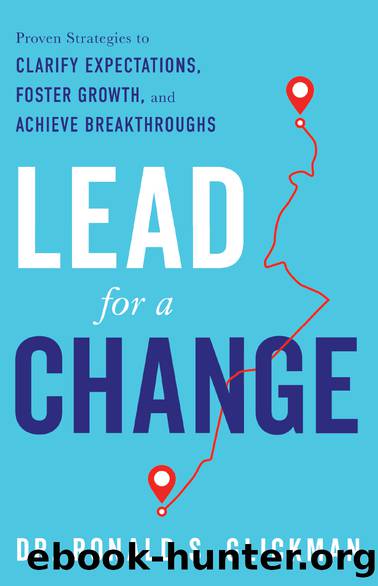Lead for a Change: Proven Strategies to Clarify Expectations, Foster Growth, and Achieve Breakthroughs by Ronald S. Glickman

Author:Ronald S. Glickman
Language: eng
Format: epub
ISBN: 9781632996404
Publisher: River Grove Books
Published: 2023-08-15T00:00:00+00:00
7Brené Brown, RSA Short: Blame, February 3, 2015, https://brenebrown.com/videos/rsa-short-blame/.
8Tony Buzan, Tony Dottino, and Richard Israel, Grass Roots Leaders: The BrainSmart Revolution in Business (London: Routledge, 2016).
CHAPTER 6
OUTCOMES ARE EVERYTHING
Itâs always easier to think that your intentions are just as important as the outcome, but this isnât true. The outcome is everything. The outcome is what you live with.
âFrances de Pontes Peebles
When I was appointed to my first corporate leadership role, I proudly shared the good news with my father-in-law, a retired executive with a treasure trove of wisdom that he endeavored to share at every opportunity. This time, he asserted that the most important thing I had to do as a leader was define the outcomes I expected my team to achieve. I accepted his counsel as a truism without understanding how challenging it would be to put it into practice. Over time, I learned that a well-defined outcome must be concise and observable. Most notably, it must represent a measurable change in performance or result. The next leadership conversation for meaningful change is about outcomes, or more specifically, a) the measurable results from a portfolio of projects curated to achieve the fruition of a strategic change initiative, and b) the organizational learning and improved morale associated with a job well done. Each project must first qualify to meet or exceed the aspirational, inspirational, and functional expectations stipulated in the P&D (see Figure 5, page 51). Next, it must align with the organizationâs current capability and willingness to change. An organizationâs capability and willingness to change are defined by individual and collective experiences, know-how, beliefs, and biases. In this context, experiences are the basis of discrete knowledge gained from doing something, know-how is the cumulative knowledge gained from multiple experiences over time, beliefs are perceptions about the way things are currently (as opposed to how they could be in the future), and biases are individual tendencies to lean in a certain direction on a topic (i.e., lacking a neutral viewpoint).
The outcomes and the organizationâs capability and willingness to change are depicted in the Outcome Alignment Model (see Figure 7). The tip of the iceberg represents the proclaimed outcomes and observable actions of a strategic project or change initiative. These components are visible. More importantly, they can be strengthened or impaired by the glacial mass representing the organizationâs capability and willingness to change. These components are less visible and often misinterpreted or ignored altogether when curating a project portfolio for a strategic change initiative.
Download
This site does not store any files on its server. We only index and link to content provided by other sites. Please contact the content providers to delete copyright contents if any and email us, we'll remove relevant links or contents immediately.
Hit Refresh by Satya Nadella(9040)
The Compound Effect by Darren Hardy(8813)
Change Your Questions, Change Your Life by Marilee Adams(7637)
Nudge - Improving Decisions about Health, Wealth, and Happiness by Thaler Sunstein(7621)
The Black Swan by Nassim Nicholas Taleb(7014)
Deep Work by Cal Newport(6884)
Daring Greatly by Brene Brown(6449)
Rich Dad Poor Dad by Robert T. Kiyosaki(6412)
Principles: Life and Work by Ray Dalio(6220)
Playing to Win_ How Strategy Really Works by A.G. Lafley & Roger L. Martin(5929)
Man-made Catastrophes and Risk Information Concealment by Dmitry Chernov & Didier Sornette(5923)
Digital Minimalism by Cal Newport;(5665)
Big Magic: Creative Living Beyond Fear by Elizabeth Gilbert(5615)
The Myth of the Strong Leader by Archie Brown(5427)
The Slight Edge by Jeff Olson(5351)
Discipline Equals Freedom by Jocko Willink(5286)
The Motivation Myth by Jeff Haden(5157)
Stone's Rules by Roger Stone(5027)
The Laws of Human Nature by Robert Greene(5001)
